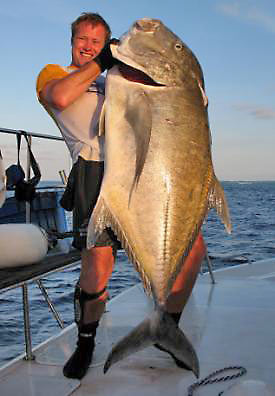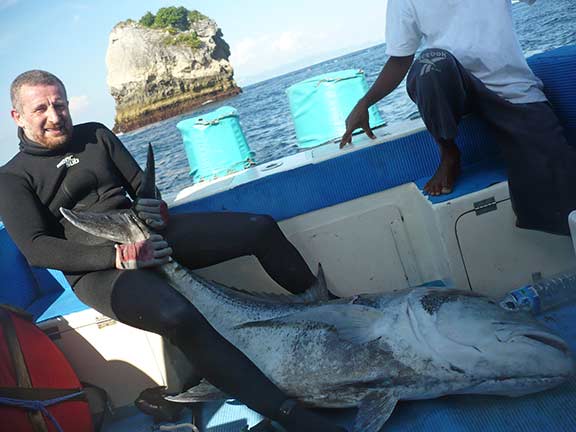On Christmas day Jason Hijirida, Sterling Kaya, Jon
Mark Kuba went out to the east side of Oahu and try our luck for some Ono's. We jumped in
to the first spot and we saw no ono's except for Kuba. Still excited with anticipation we
decided to check a different ledge. As we were driving the boat to the next spot as was
jokingly saying how I never go to test out my new gun. I had only shot chum up to this
point with it.
Finally arriving at our new spot we anchored the boat and jumped in.
I was the first in followed by Sterling Kaya. As I made my way toward the ledge I could
see what I thought was a big Kagami swimming mid water. The reason why I thought it was a
kagami was because that thing was so damn tall. Anyway, as it got closer I realized that
it was an Ulua (GT) so I dropped to 15 ft. took aim and fired a shot as it was still
making its way toward me. As the shaft hit the fish it froze and floated up to the
surface. Happy that I shot this big fish but I only thought that the thing weighed 80 lbs
or so. As we made out way back to the boat I realized that this fish was maybe a little
bigger than I thought.
When we got the fish on board we took estimates on how much it weighed. I heard 100,
115, and even a 150. At the time we all thought that was pretty funny. Who would have
guessed, the estimate would be the closest. Everything was done on my own; no one touched
the fish until I got it back to the boat.
***************************************
Previous World-record Giant Trevally for men—121.0 lbs. (54.88 kilos)
by L. Springall, Lizard Island, QLD, Australia, 10/18/72
***************************************
Notable catch- Giant Trevally for
men—"A massive kingfish" by Denham Howe, an atol, Mozambique,
Dec 6,2007

My father, Derek Howe, and two of his friends own a
44ft charter catamaran named “Bengithi”, which has been chartering out of Pemba, Mozambique. With hurricane season approaching, I flew with 5 friends from South Africa to Pemba to help sail “Bengithi” the length of Mozambique to Maputo. As we had
ample time, we cruised around a little and on the 6th of December myself,
Gareth Wills, Bryn Mcgibbon, and Wesley Kriedeman left the yacht on the rubber duck to go
freediving along an atoll. Bryn, by the way, had flown from Australia to come sailing with us.
Although I have speared for enjoyment occasionally over the past
few years, I had not been in the water with a gun at all in 2007, until 6 December.
After being in the water for about an hour in one location,
enjoying my first real close up encounter with a group of about fifteen sharks, we
repositioned ourselves closer to the edge of the atoll. We were drifting along a drop-off
from 6m to 10m deep and after perhaps another hour, Wesley had speared a very big Green
Jobfish and I had speared my biggest Giant Trevally so far of around 10kg. Happy with our
success for the day, I said to Wesley that we should unload and go back to the yacht.
I unloaded both rubbers on the Rob Allen Railgun that I was
borrowing and swam towards the rubber duck. As I neared the duck I noticed the biggest GT
I had ever seen approaching the duck from the opposite direction, cruising along the
drop-off. He swam right up to the duck and had a quick look at what he must have thought
was an interesting pile of debris. At this stage the fish was about 8m away from me.
Cursing my unloaded gun and seeing that Wesley was some distance
away, winding up his buoy line, all I thought to do was stick my head out of the water and
shout to Gareth and Bryn, who were casting poppers off the duck, “turn around, look
over there”. Gareth, seeing a “dark shape” from above the surface, simply
flicked his popper at it and began retrieving. I ducked my head back under the water,
expecting to see the fish dart off into the blue. But he was just lazily swimming past me.
Now that he was closer and I could see his truly majestic size, I
realized that he was not at all threatened by our presence or the 11 small sharks in the
vicinity. He was the “Massive” Kingfish and he intended to cruise off in
unhurried style.
With him slowly passing me by, I figured I might just have one
chance to load a single rubber. I carefully, but quickly, grabbed the lower rubber, forced
the butt of the gun into my unpadded chest and made absolutely sure I landed the cable in
the spear notch. Bringing the huge GT back into my line of sight, I saw that he was about
to swim out of range. I ducked under and swam down a few metres in his direction, aiming,
reaching forwards and praying that he didn’t strip me of gun, line and buoy in one
second flat.
I fired. The gun was immediately ripped from my glove and I
grabbed the line a few metres back. With adrenalin surging through my heart I gripped the
line hard and realized that I was holding him from his run. He was weak. I had hit him
right on the edge of my range and the spear didn’t even penetrate all the way through
his wide body, but it had obviously nicked his spine and he couldn’t fight with his
full strength.
Wesley and Bryn hung around me to keep the sharks at bay while I
pulled the GT up to my body, gave him a bear hug and brained him. Even a number of wounds
to the head wouldn’t fully drain the life from him, so we hitched a rope around his
tail once I had him next to the duck. Once he was loaded aboard the duck, we sped off,
back to “Bengithi”, to show our friends this truly massive fish.
****************************************************************
The
Great Fish
Nusa Tengara- Indonesia 24th april 2009 by Gian Marco Antignani

It’s
three o’clock in the afternoon, it’s
new moon, the top of high tide. With
two boats we go back to the main
spot.
The
other boat resolves to leave the place. The flow and the waves were clashing so strongly in a water storm that precludes the use
of fins in diving.
I
decide anyway to try: I wait for some minutes on the boat watching the movement of the sea
and I realize that the waves were calming down; I get down in the sea and I bring near to
the drown rock that is my bench mark.
The
sea calms down at all: the waves stops and the flow becomes a slow circular motion.
During
the first dives, I don’t make out
nothing, only schools of little fishes, they are the preys of big pelagic fishes that live in the spot: giant trevally and dogtooth tuna.
I
dive again and I glide following the flow. A school of many carangids comes to me against
the flow: they are giant trevally and some of them are big - 20 or 30 kilograms – but
I ignore them, I am looking for the big fish.
Suddenly
comes into view a big GT, it would be almost 40 kilos or more, I prepare myself to shoot
and I use the fins slowly not to scare it, the fish inverts the course and goes away with
an imperceptible movement of the fishtail and in
a few seconds it’s out of focus.
The
current carries me very far from the drown rock and it takes me half an hour to go back to
the tired point of the flow. I prepare myself for the next dive, knowing that I have to
dive down to almost 15 meters of deepness and
glide looking for the school.
I
dive down and stay horizontal then I line up
the gun: the big GT is on my left, behind it the rock falls sheer.
At
this time I use strongly the fins, I need to seal off the way to the fish before it goes
over the drop off: the fish is under fire, the shaft hits
it on the right side , it leaps up and warp as
if it turns vertically with the muzzle throw the surface, but slowly goes down to the bed
of the sea.
I
am sure that the shot is good: the reaction of the fish is mild, on the surface the two
big floats to which the shaft is connected move slowly.
I
dive again to understand better the situation, and I see the line of the floats tightens
to the top: the fish is going to the surface it means that the shot was lethal.
The
recover is easy, there is not any fight: the big fish is won. The slip- tip is thrust in
the vital organs: under the lateral line close
to the bone plait of the gill.
The
Giant Trevally (Caranx Ignobilis) was 68,700 Kilos, for a length of cm 148 measuring
from the top of the muzzle to the hollow of the caudal fin. I didn’t note down the
width and a kind fisherman of the place weighted the fish with it’s old job’s scale.
|